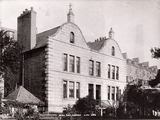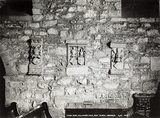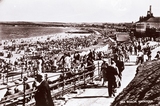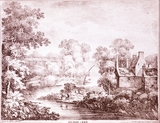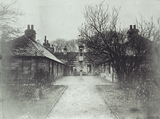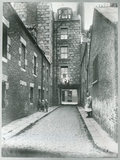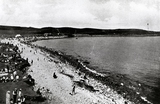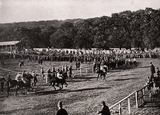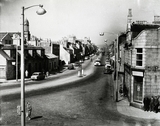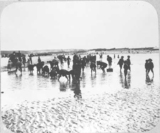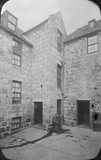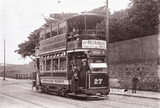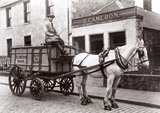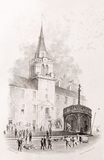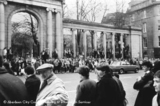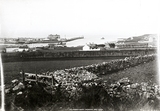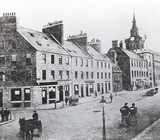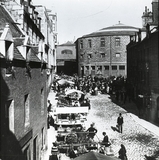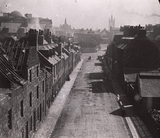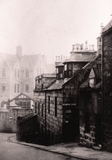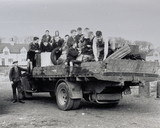|
Quick Search
|
Search Results
You searched for: More Like: 'Past Times'
428 items
items as
Mackie Place
33 4-5 Mackie Place, Aberdeen, c.1870. The street was named after Robert Mackie, a skinner who was Convener of the Incorporated Trades.
At No.6 there was a haunted house known as the 'The Castle'. The Denburn flows past the back of the building. When first built, the address was 'The Galleries'. Collison's Aisle, St Nicholas Church
46 This George Washington Wilson photograph shows the memorial stones inserted in the west wall of Collison's Aisle. Originally called Aisle of the Holy Blood, it formed part of the north transept between the East and West Churches of St. Nicholas and was renamed after 1594, although it probably dates from the 14th century. Members of the Collison family held important civic offices at various times, including Provost in 1521 and 1594, and their place of burial was in this aisle. The memorial stones commemerate Andrew Cullen, Thomas Menzies and his wife Mariene Reid, and Sir John Rutherford. Andrew Cullen was a merchant and Provost of Aberdeen in 1506 and 1535, and the stone shows a sculptered coat of arms above the words "Andrew Cullen Prepositus Abd". Thomas Menzies was Provost in 1525 and (for 40 of the next 50 years), only leaving office in favour of other members of his family. He married Mariane Reid of Pitfodels. The stone has two panels above a shield bearing the Menzies coat of arms, flanked by the initials T.M. The second panel has the initials M.R. and a shield with the Menzies and Reid coats of arms. Beneath is the motto 'Spero in Deo et ipse faciet' - Trust in God and he will perform'. The third stone commemorates Sir John Rutherford of Tarland, first elected Provost of Aberdeen in 1483 and every alternate year until 1492, and again between 1496-1500. He probably died about 1520. Aberdeen Sea Beach
51 The Promenade at Aberdeen Sea Beach, c. 1950 with the Beach Shelter and Beach Bathing Station in the background. Brig o' Balgownie over the River Don
168 An engraving showing the Brig o' Balgownie over the River Don from a drawing by James Giles. The inscription in the bottom right indicates that the engraving was printed at the Deaf and Dumb Institution.
The title of this engraving describes the Brig o' Balgownie as the Bridge of Don. This is due to it serving as the main bridge over the river until the construction of the bridge known today as the Bridge of Don in 1827-30 by engineers John Smith and Thomas Telford.
This image likely looks south east along the river, towards the bridge, from between Tam's Hole and Black Nook. This was an important salmon fishing area in the past. Some information on the catching of fish on the river is given in the book The Annals of Aberdeen (Volume II, 1818) by William Kennedy, on pages 206-211. Mitchell's Hospital, Old Aberdeen
171 Mitchell's Hospital is situated in the Chanonry not far from St. Machar's Cathedral in Old Aberdeen. It was founded and endowed in 1801 by David Mitchell, a native of Old Aberdeen. It was set up for the purpose of lodging, clothing and maintaining five widows and five unmarried daughters of Old Aberdeen merchants. The women who lived there dressed in deep blue, and those who were able to earn some money from spinning or knitting were expected to give half to the hospital. The building is of one storey in the shape of a letter 'H' with a central refectory for breakfast. Depending on the cost of beef, dinner was boiled beef and greens two or three times a week, otherwise they had fish or eggs. The building has now been reconstructed into four separate dwellings. Shuttle Lane prior to slum clearance
193 This 1930s photograph shows the Shuttle Lane slum clearance area situated between East North Street and Frederick Street, before the families were rehoused on new estates.
These houses were typical of the cramped, overcrowded tenements to be found in most Scottish cities. Large families would be crammed into 1 or 2 rooms. There might have been a shared toilet on the landings or more commonly outside in the back yard.
Infectious diseases such as diptheria and scarlet fever could be spread rapidly with such close contact of families, and infant mortality was high. There was often no drying green so many tenements had iron washing poles which could be slid out of windows when needed. Each family would have their allocated day to use the wash house.
Washing clothes was a laborious affair as the mother, maybe with the assistance of an older daughter, would stoke and light the boiler, and trek back and forth with water from an outside tap. Washing would be done by hand and if the weather was bad, then it would have to be hung inside in the kitchen to dry in the heat of the coal fire.
However, it seemed that community spirit was warm and close neighbours helped each other in times of crisis. This was a bond that would be broken when families were rehoused in the modern housing estates. Seaton Park Racecourse, 1928
259 This image shows one of the last races in Seaton Park at a meeting held on Saturday 22nd and Monday 24th September 1928.
Horse racing had taken place in the city regularly in the 19th century when there was a racecourse at the Links. Its popularity had declined but racing was revived in Seaton Park in 1923 when 30,000 people attended.
The 1928 Meeting was not a great success since less than 1000 spectators attended on the Saturday, although 3000 attended on the Monday despite intermittent rain. The entrance fee to the ground was 1/6 (seven and a half pence) and to the Paddock 4 shillings (20p) with licensed bars, refreshments and teas available.
The fields were not large with only 5 runners in the main events. The Bon Accord Handicap, run over 7 furlongs, had prize money of 25 sovereigns. The last race on the Monday was the Consolation Handicap (for beaten horses). Only 3 horses ran, with "Lolita" winning by 6 lengths. The third horse "Peggy Maitland" was so far behind that her owner/jockey had to walk her past the post.
An application made in 1956 to restart horse racing was turned down by the Town Council. Great Northern Road, Woodside
287 Today Woodside is a busy and thriving community with a dual carriageway and railway running through its heart. Modes of transport and services have changed radically over the past two hundred years but due to its location Woodside has always been part of a wider network and this has helped to drive industry and increase travel. Children catching shrimps at Aberdeen Sea Beach
341 Children catching shrimps at Aberdeen Sea Beach. James Beattie's House
362 This house stood in Crown Court at 36 Upperkirkgate, Aberdeen. It had an internal stone stair and some of the rooms were oak panelled. James Beattie was born in 1735 in Laurencekirk and in 1760 he was appointed Professor of Moral Philosophy at Marischal College. He died at this house on 18th August 1803 and was buried in St. Nicholas Churchyard.
His house became the home of an advocate, but in the 1850s and 60s it was used by the Aberdeen General Dispensary, lying in an vaccine institution which supplied advice and medicines to the sick and poor. In more recent times, the area behind the Upperkirkgate was cleared and redeveloped as the Bon-Accord Shopping Centre.
Correspondent Ed Fowler suggests that the items that can be seen in front of the house are likely early Victorian laundry mangles. This would account for the trail of water draining from its position. The tarpaulin that is visible would have been to protect the wooden rollers and gears from the elements. The drying area was probably in the garden beyond the Dispensary building, to the north, as no improvised window drying jibs are visible. No. 27 Tram
392 Many thanks to Silver City Vault users Dr Mike Mitchell and Brian Kennedy for providing us with information on this photo. It shows the no. 27 tram on Victoria Road with the wall of Balnagask House in the background.
The Balnagask Mains farm is partially visible to the left of the tram. The St. Fittick's Road terminus of the Torry Route is located further along Victoria Road.
The female conductor indicates the photo was taken during the Great War. The tram waits to depart for Bridge Street. D. Cameron, Bakers
442 A photograph of Mr D. Cameron on his horse and cart and outside his bakery and confectioners shop at 76 Skene Square.
This photograph was taken by Kidd & Stridgen of 33 New Market Gallery, Aberdeen.
A copy of this image was kindly lent to the Aberdeen City Libraries for reproduction by William Donald of Udny Green.
Local historian A. G. Duthie has been in touch to suggest that if we look at the Ordance Survey from 1902 (Aberdeenshire sheet 075.11), judging by the shape and position of the buildings, there is a plausible location for this building north of Skene Square School on the other side of the road. Old Tolbooth
485 Old Tolbooth, Aberdeen, from an etching by J. Skene. This view of the Tolbooth shows the Market Cross in front of it. The Tolbooth was built in 1615. In recent times, it was converted to a museum. Double outside stairs lead up to the main entrance. On the east side was the New Inn. Most of the building is obscured by the modern Town House development. Aberdeen Football Club European Cup parade
650 Aberdeen Football Club European Cup parade up Union Street past the facade of St. Nicholas Churchyard in 1983 The Harbour Mouth, Aberdeen
657 A George Washington Wilson photograph titled The Harbour Mouth, Aberdeen and numbered 505.
The image looks north east from the fields above Old Torry. Point Law, dividing the River Dee channel and the Tidal Harbour, is largely undevelopment. It looks like construction work may be going on over the water at Pocra Quay.
Correspondent Ed Fowler suggests that the large temporary looking building that can be seen across the water, past the round house on the New Quay, is of particular interest. He posits it was used to cast concrete blocks for an extension to the North Pier between 1869-77. Castle Street
673 A view of the buildings at Castle Street prior to their demolition for the construction of the new Town House (1867-1874) designed by Peddie and Kinnear.
The entrance to Broad Street is visible in the left foreground. The entrance further on is to Huxter's Row, which turned west and ran behind these building to exit on Broad Street. The Lemon Tree Hotel and the Bon-Accord Hotel were located on this lane. The former soon moved to 7-9 St. Nicholas Street.
Past the fortified facade of the Tolbooth, and its prominent spire, can be seen the entrance to Lodge Walk and Archibald Simpson's North of Scotland Bank premises, opened in 1842.
The signs in the shop windows likely give notice of imminent closure. A sign for Alexander Badenoch, an outfitter, can be seen at 12 Union Street. Further down, at what is likely Chapman and Co., tailors and clothiers, "Great bargains" are advertised.
In addition to the gas lamps and pollards, there is array of traffic on the cobbled street. Two night watchmen stand talking on the left. A Gordon Highlander, presumably coming from the nearby Castlehill Barracks, is outside Badenoch's shop. Two fishwives carry leaden creels to market. A large dog sleeps outside Chapman and Co. and various horse drawn vehicles are shown. Market day in The Green
686 The curved wall of the popular New Market dominates this view while farming folk are gathered round the 'Mannie in the Green' street well to sell their butter and eggs, vegetables and flowers at the Friday market. The New Market was demolished in 1972 to be replaced by the Aberdeen Market, and the 'Mannie' returned to his orginal home in the Castlegate. Upper Denburn
729 Upper Denburn, looking east, prior to its demolition.
Brick gable tenements can be seen on the left already stripped of their roofs.
The viewpoint is looking from the Dyers Court area eastwards towards Marischal College Tower and the retaining wall of the Royal Infirmary (with its dome on the skyline). This lead to Spa Street and Woolmanhill beyond.
The houses and tenements on the right are more sparse and primarily traders yards.
Garden Nook Close led off the left past a timber yard to the Well of Spa. The Well O' Spa Pub was on the extreme left corner.
Note the partial visible trade sign on the ridge of the distant roof - most likely James Stephen & Son. They were carvers, gilders/ornamental plasterers, mirror & picture frame makers, artists' colourmen and fine art dealers and operated at 48-50 Woolmanhill from around 1890-1933. Gordon's Hospital Spire rises beyond these premises.
(Many thanks to Ed Fowler for the above description). Jack's Brae and March Lane
773 A photograph looking south east down Jack's Brae, past March Lane, towards upper Denburn in 1927.
The Ordnance Survey town plan from 1866-67 indicates that the buildings at the foot of Jack's Brae, beyond March Lane, and shown in the centre here, had a tannery to their rear. All these buildings on Jack's Brae were demolished and the land is now a green space.
The substantial granite building in the background on the left is Skene Street School, later known as Gilcomstoum Primary School. The wall that can be seen at the junction of Upper Denburn remains at the time of writing in 2022.
A city royalty boundary stone, marked "CR" can be seen underneath the March Lane street sign. Wellington Lodge
811 A photograph showing Wellington Lodge on the corner of Justice Mill Lane and Holburn Street.
The top of Holburn Street, towards Holburn Junction, was previously known as South Street and later as Wellington Place. In the background of this image, on the far left, can be seen the John Smith designed Water House on Union Street.
Wellington Lodge stood across the road from Holburn Church, roughly where the Glentanar Bar stands today. It can be seen on the large scale Ordnance Survey town plan and map sheets from the 1860s.
The property appears to have belonged to the Whytes of Dalhebity, Cults. For some time Wellington Lodge was the residence of Helen Whyte and she was likely the house's final resident.
Helen Whyte died aged 85 on 31st January 1898 (death notice: Aberdeen Weekly Journal, 09/02/1898, p. 4). Newspaper references suggest she was involved in various charitable activities. She was the daughter of Baillie John Whyte, a merchant, and had a brother also called John Whyte (1845-1904), a prominent citizen and advocate.
Another death notice indicates that Mary Ann Hardie, of 48 Victoria Road, Torry, was employed for 38 years as the servant for Miss Helen Whyte. Hardie died in 1895 (death notice: Aberdeen Journal, 17/08/1895, p. 4).
Newspapers also suggest the villa was the home of Miss Mary Murray Gordon. She would likely have been a relation of James Murray Gordon who was a partner in the same law firm as John Whyte, Helen's aforementioned brother.
Wellington Lodge was probably demolished shortly after the death of Helen Whyte. It made way for the extension of the larger tenement buildings on Holburn Street that can be seen in the background of this photograph.
The Aberdeen Weekly Journal's 'Granite Chips' column of 17th May 1899 (p. 9) states "A very large and handsome block of buildings for Mr Peter Farquharson has been erected in Holburn Street, stretching from the office of the Union Bank of Scotland to Justice Mill Lane." This most likely refers to this development.
David Miller in Archibald Simpson, Architect, His Life and Times 1790-1847 (2006) states that this villa was designed by Simpson for Mrs Yeats of Auquharney (page 174). Culter Boys' Brigade
1002 Culter Boys Brigade collecting wastepaper and scrap metal during World War 2.
As indicated on its side, the lorry belonged to William L. Gavin of Kennerty Mills. Gavin ran Kennerty Mills, in the south west of Culter, for nearly 50 years and was a past president of the Scottish Oatmeal Millers' Association. He was also an Aberdeen county councillor and a Justice of the Peace. Gavin died aged 90 on 14th July 1987. A brief obituary for him can be found in the Press & Journal of 16th July 1987 on page 3.
Correspondent Brian Coutts has been in touch to identify some of the boys on the lorry: "Bill Moncur (hiding behind a newspaper), Dennis Booth, "Jeeker" Broon, Bill Dey, Derek Thom, Derek Stephen and Adrian Semmence." Settmaker at Persley Quarry
1071 The Aberdeen area had many granite quarries, and there was a need for men who had the skill to reduce huge blocks of granite into manageable pieces by chipping it with a variety of hammers, and chisels to produce the required shape and size. In this 1920's photograph we see a settmaker at Persley Quarry on the north side of the River Don in Aberdeen, at his wooden shelter or 'skaithie'. These shelters provided some sort of wind break for these men who had to sit on blocks of granite patiently working on the hard stone. Settmakers made cassies for roads and Aberdeen setts were used to pave streets in London. On his left is a tripod structure which acted like a small crane to lift the bigger stones into position. Note the lack of protective safety equipment apart from some extra padding on his knees. Jubilee bonfire on Brimmond Hill, Bucksburn, 1935
1139 During the 16th century, Brimmond Hill, in the parish of Newhills, was designated the site of a warning beacon, or "fyer bitte", to be lit in the event of a Spanish invasion.
In more recent times, celebratory bonfires on Brimmond have marked important national events. In this photograph, we see the bonfire built in honour of the Silver Jubilee of King George V and Queen Mary.
An advertisement in the local press intimated that "Lady Orr, Wardenhill, will set alight a thousand loads of wood to blaze sky-high the Loyal Greetings of Bucksburn and all the Parish of Newhills. This is the biggest bonfire in Britain. A wonderful spectacle." |



